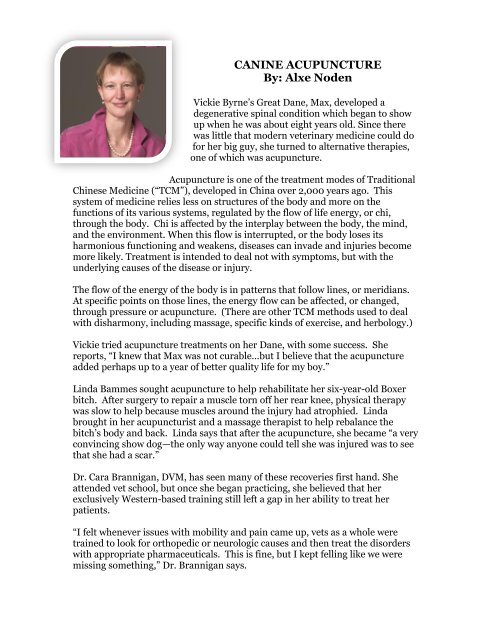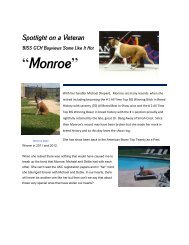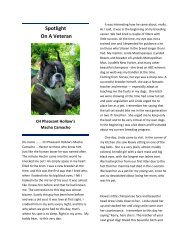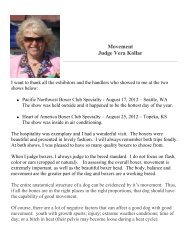CANINE ACUPUNCTURE By: Alxe Noden - Boxer Daily
CANINE ACUPUNCTURE By: Alxe Noden - Boxer Daily
CANINE ACUPUNCTURE By: Alxe Noden - Boxer Daily
You also want an ePaper? Increase the reach of your titles
YUMPU automatically turns print PDFs into web optimized ePapers that Google loves.
<strong>CANINE</strong> <strong>ACUPUNCTURE</strong><br />
<strong>By</strong>: <strong>Alxe</strong> <strong>Noden</strong><br />
Vickie <strong>By</strong>rne’s Great Dane, Max, developed a<br />
degenerative spinal condition which began to show<br />
up when he was about eight years old. Since there<br />
was little that modern veterinary medicine could do<br />
for her big guy, she turned to alternative therapies,<br />
one of which was acupuncture.<br />
Acupuncture is one of the treatment modes of Traditional<br />
Chinese Medicine (“TCM”), developed in China over 2,000 years ago. This<br />
system of medicine relies less on structures of the body and more on the<br />
functions of its various systems, regulated by the flow of life energy, or chi,<br />
through the body. Chi is affected by the interplay between the body, the mind,<br />
and the environment. When this flow is interrupted, or the body loses its<br />
harmonious functioning and weakens, diseases can invade and injuries become<br />
more likely. Treatment is intended to deal not with symptoms, but with the<br />
underlying causes of the disease or injury.<br />
The flow of the energy of the body is in patterns that follow lines, or meridians.<br />
At specific points on those lines, the energy flow can be affected, or changed,<br />
through pressure or acupuncture. (There are other TCM methods used to deal<br />
with disharmony, including massage, specific kinds of exercise, and herbology.)<br />
Vickie tried acupuncture treatments on her Dane, with some success. She<br />
reports, “I knew that Max was not curable…but I believe that the acupuncture<br />
added perhaps up to a year of better quality life for my boy.”<br />
Linda Bammes sought acupuncture to help rehabilitate her six-year-old <strong>Boxer</strong><br />
bitch. After surgery to repair a muscle torn off her rear knee, physical therapy<br />
was slow to help because muscles around the injury had atrophied. Linda<br />
brought in her acupuncturist and a massage therapist to help rebalance the<br />
bitch’s body and back. Linda says that after the acupuncture, she became “a very<br />
convincing show dog—the only way anyone could tell she was injured was to see<br />
that she had a scar.”<br />
Dr. Cara Brannigan, DVM, has seen many of these recoveries first hand. She<br />
attended vet school, but once she began practicing, she believed that her<br />
exclusively Western-based training still left a gap in her ability to treat her<br />
patients.<br />
“I felt whenever issues with mobility and pain came up, vets as a whole were<br />
trained to look for orthopedic or neurologic causes and then treat the disorders<br />
with appropriate pharmaceuticals. This is fine, but I kept felling like we were<br />
missing something,” Dr. Brannigan says.
Brannigan became more and more concerned as the use of “medication cocktails”<br />
grew into the standard of treatment. “I never felt we should abandon the proven<br />
scientific medications,” she says, “but we should do everything we can to<br />
maximize relief while minimizing risk.” She realized that acupuncture could be a<br />
part of her treatment protocol.<br />
Like most states, Colorado (where Brannigan practices), requires that<br />
acupuncture treatments on animals must be performed by a licensed<br />
veterinarian. Therefore the people taking the acupuncture courses suggested by<br />
the American Academy of Veterinary Acupuncture are all Western-trained vets<br />
with an existing idea of diagnosis and treatment. Most acupuncture treatments<br />
are therefore informed by a combination of Western diagnosis and some TCM<br />
diagnosis. For example, Brannigan utilizes the DATE system, which involves a<br />
physical examination of the animal to determine what acupuncture points are<br />
sensitive to touch. (A chart of some of the acupressure points on a dog is<br />
available at http://www.luckydoghealth.com/dogacupressurechart.htm.)<br />
In addition to the physical exam, most acupuncturists will take a medical history,<br />
and ask to see results of (or order) blood tests, x-rays, and the like. Often it’s<br />
useful to the acupuncturist to understand something of the environment where<br />
the animal lives; Marilyn Woods-Brown, DVM, likes to hear about what other<br />
animals are in the household, whether there are stairs in the house, what the dog<br />
eats. These all give a clearer picture of both the animal and the things that might<br />
affect its health.<br />
Once the acupuncturist has determined a diagnosis, they will have the animal sit<br />
or lie down in a comfortable position. Many treatments are done at home by vets<br />
making house calls; both Brannigan and Woods-Brown like to work where the<br />
animal is calm and not threatened. Needles are inserted at various points in the<br />
body, usually using small plastic tubes as guides and stabilizers. The needles stay<br />
in about a half hour. Brannigan estimates that 99% of dogs will tolerate this<br />
treatment well; she says cats are by far the most difficult patients! You can see<br />
parts of an actual treatment on YouTube at:<br />
http://www.youtube.com/watch?v=X9PONItkEUs.<br />
Not everyone is convinced by the anecdotal evidence. David Ramey, DVM,<br />
practices equine medicine in southern California, and writes, “In fact, other than<br />
testimonials, there’s really no good evidence that acupuncture does work in<br />
animals.” Though he admits that some studies have shown positive results, these<br />
were “poorly designed” (though he does not specify how). (See his article and<br />
citations at http://www.sciencebasedmedicine.org/index.php/animalacupuncture.)<br />
Dr. Brannigan points out that acupuncture, whether on humans or in animals, is<br />
difficult to study using traditional double-blind study methods. For one thing,<br />
how can you fake putting in needles? She points out that “sham acupuncture,”<br />
where needles are placed randomly in people, not on actual acupuncture points,
still results in relief, possibly due to the placebo effect. This would be even more<br />
challenging in animals, who can’t describe how the treatment feels or its results.<br />
With or without studies to back them up, many veterinary acupuncturists see<br />
results for treating a wide variety of conditions, including arthritis, digestive<br />
problems, reproductive issues, and heart troubles. Chronic pain associated with<br />
bone or nerve problems seems especially susceptible to acupuncture treatment.<br />
Jenifer Sarnosky saw her Welsh Corgi go from being in so much pain that he<br />
occasionally lost the use of his back legs, to a complete recovery of mobility with<br />
only two acupuncture treatments. He lived another 10 years pain-free, until the<br />
back problems caused by the original ruptured disk returned and she had to put<br />
him down.<br />
Recovery is not usually so quick. Woods-Brown tends to treat acute pain, such as<br />
disk problems with paralysis, more aggressively, with as many as two treatments<br />
per day for two or three days, then perhaps two times per week for a period after<br />
that. Generally she treats a chronic condition one time per week for three weeks,<br />
and then determines further treatments based on results. Some animals have<br />
regular monthly treatments for their entire lives.<br />
Costs for canine acupuncture vary widely depending on geography. Most often<br />
the first treatment is more expensive, since it takes longer to get a full medical<br />
history and diagnosis; later treatments are usually cheaper. In New York or<br />
California, you might pay $150 for an initial visit and $100 per treatment after<br />
that; in the middle parts of the country, you might pay $75-80 for the first<br />
treatment and $50 thereafter, depending on whether your pet is seen at home or<br />
in a clinic.<br />
Though the efficacy of acupuncture might be disputed, and its action not fully<br />
understood, many believe in it. Dr. Brannigan tells the story of a young Labrador<br />
who was hit by a car, resulting in cranial and facial fractures and damaged<br />
nerves. Once everything that Western medicine had to offer had been tried to<br />
heal him, he was still left with a significant facial “droop” on one side: drooling<br />
lip, pulling lower eyelid, crooked nose, and lack of motion. When every other<br />
treatment failed, Dr. Brannigan tried acupuncture on the dog, with startling<br />
results. His droop improved markedly and his face returned nearly to normal.<br />
It’s stories like these that keep people coming back to acupuncture to help their<br />
dogs.








